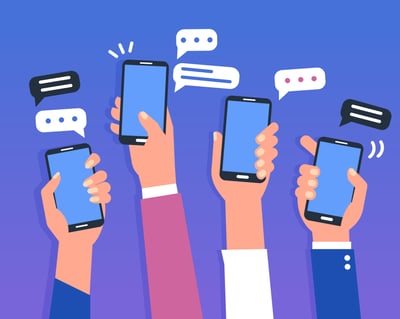March 30, 2021
 by Kevin Daniel / March 30, 2021
by Kevin Daniel / March 30, 2021

Is email marketing dying?
Quick answer: email marketing is light years away from being dead.
Email marketing is the only channel where you can build a solid audience and it’s probably the one marketing channel you should rely on.
Imagine you have 1,000 customers that are loyal to your brand and are willing to buy almost every product you promote. The only reliable way to stay in touch with them is through emails.
That’s the power of email marketing.
Email marketing is the use of email to promote your brand’s products or services. Email marketers send articles, special offers, and company updates on a regular basis to a subscriber base.
Email marketing is all about using emails to promote content, products, or services to a list of subscribers – contacts who allowed you to get in their inbox.
Any time you send an email for marketing purposes, you’re doing email marketing.
Email marketing has evolved over the years, going from “massive broadcast promotions” to a more targeted approach involving personalization and segmentation.
Personalized emails work because it leverages the trust that your audience already has on you when they subscribe to your list – hence more sales.
This means that modern email marketing typically involves setting up emails that are “triggered” based on customer behavior, segment, and testing. The how, when, and who you send your email is where email marketing becomes an art.
Let’s go through the seven core benefits of using email marketing as a main marketing channel, even in today’s highly modernized world.
Do you know someone who doesn’t have an email? According to Statista, there are 3.9 billion people using email actively.
The fact that pretty much everyone in your market has an email means a lot. Because you won’t have to conduct market research to know if your target customers use email, or educate your audience on how to use email to communicate with you – because they already do.
Rejecting email marketing because “email is outdated” is just an excuse to avoid leaving the comfort zone.
There’s an apparent difference between reading a Facebook post and an email. The email is specifically made for you (and only you can read it). While the Facebook post is a public message that’s accessible for everybody.
That’s why people react differently to those formats (and why email is far more effective).
Ian Brodie – consultant and author of multiple marketing books – explains it in few sentences:
Email feels personal because only you can read and interact with your emails, no one else. Even if you intellectually know that you’re receiving the same content as others, your subconscious is more open to paying attention to what it says than if you were reading it on Twitter.“When you read material on a website, blog or even on a social media site you know it’s a broadcast. You know it’s meant for multiple people and read or watch in that context. But emails are different. They sit in your inbox next to the messages of your friends, relatives, colleagues, and clients. There’s just something about receiving an email in your own personal inbox that makes it feel like it’s been made just for you.”
Thanks to email management software, you’re now able to schedule, program, and “set and forget” your email campaigns.
Just imagine that for every new subscriber, you’d have to manually write and send a welcome email – it would be as inefficient as eating a soup with a fork!
Sonia Simone – an ex-CopyBlogger – have some arguments on why autoresponders are the lazy marketer’s best friend:
“It never gets tired. It never needs the weekend off for Father’s Day or Mother’s Day (or Email Autoresponder’s Day). It never gets bored with your marketing message. It never gets snarky. It never gets sick of newbies. It delivers your best content, in the best possible order and frequency, to every new reader who finds you. Forever.”
If you want to build a successful blog, you’d need to hire a team of writers. But if you want to run a successful email list, you’d barely need one copywriter to write your emails, or an email marketer to set up everything for you – the software takes care of the rest.
Effective marketing is all about getting your prospect from point A to point B.
Point A being unaware of your brand and passive, and point B being totally aware of your offer and ready to become a customer.
And the reason emails are so loved is because they move your leads one step closer to the sale – just like having a customer machine with minimal maintenance.
What’s better, it not only converts strangers into customers. It also converts customers into loyal followers and allows you to build a community.
Imagine having a group of people who recommend your brand to their friends and also defend you on social media in your back – that’s the kind of customers you want.
A marketer like Ben Settle is the perfect example of building an email community. He has a big email list of online business owners who are ravingly waiting for his daily emails (very valuable emails), and who are ready to buy his affiliate products on a daily basis.
They’re so engaged with Ben’s emails that he even refers to them as his “horde”. Which shows how close he is with his community.
Email is the most profitable marketing channel.
No exaggeration – DMA studies show that you get $42 for every $1 you spend on email marketing.
This is a very well-known but misunderstood stat in the marketing industry. Because it doesn’t mean that you’ll generate $4.2 million from investing $100,000. The main reason why email marketing provides such ROI is because it’s cheap. And its potential of revenue has no ceiling because there’s no limit to the size of your audience.
And yes, email marketing can provide tons of revenue, but it’s not a guarantee just because you “invested”. Revenue comes from great marketing strategies and it will always be like that.
So the benefit of email marketing here isn’t the ROI in itself. it’s the fact it has a low entry cost for you to get started – debunking the “don’t have the budget” excuse.
Email lists are one of the most flexible things in the world. It doesn’t matter if your laptop explodes, if the software you use shuts down, or if Gmail stops being the most used email provider – your audience will always be safe in a .csv file – as simple as that.
You can always migrate your subscribers, remove invalid emails, add new emails, and even delete them. Your subscribers belong to you and not to Facebook or Twitter.
So many businesses are vulnerable to social algorithm changes while craving more followers and interactions. But no business is vulnerable to “email protocol changes” or something like that. That’s why a subscriber is worth more than a follower.
A subscriber is looking forward to receiving content from you and reading it, while a social follower just so happens to see your profile picture in their feed and let their instinct decide if you’re worth their attention.
Email marketing is the best channel for customer research.
There’s no need to post an idea on social media and see how random people react. On email, you’re reaching out to your ideal customers to confirm what resonates with them.
If you have a big enough list, you no longer need to do much market research. In fact, you can just ask questions to your audience and see their response. Or if you’re more methodical, send a survey link to them to see how they reply in comparison to other channels.
The possibilities are endless.
Experimenting with your list allows you to define your business for the long run. As you’ll find:
If you already have a business, getting started with email marketing only requires three steps.
First off, you need contacts to send emails to. If you already have lead’s emails in one of your business’s databases, that’s good. But in order to sustainably generate subscribers and grow your business you need a lead generation strategy. This involves:
Once you’ve set up your lead generation channel. It’s time to select your email marketing tool. How many features you need depends on what type of business you run and the kind of audience you’re speaking to. But most of the time, you want to start simple and expand later on.
Overall – and to avoid having to migrate your list in the future – these are the features you’d want to look for:
Check out the best email marketing software and make a decision.
Now, you just need to start playing the marketing game. Start by outlining what kind of emails you need to send first. Deal with the basics first, and then you can start experimenting. However, you first need to understand that your email campaigns will depend on whether they’re broadcast or triggered.
Broadcast emails are sent to your whole list at the same time without requiring any action. They’re normally used to communicate news about your business, seasonal content, or some promotions.
You can schedule broadcast emails and they’ll still be considered broadcast. The key is that it doesn’t require a specific condition of your subscribers to be sent.
Broadcast emails include:
Triggered emails are sent whenever a subscriber performs a specific action, such as clicking on a link, buying a product, attending a webinar, etc. These emails are more targeted and specially written for maximum performance and to achieve a purpose. Some of these include:
When doing email marketing, growing your email list is the main focus. More leads mean more money. That’s why you need to actively get more subscribers over time and follow some best practices like these.
Random eBooks, PDFs, or “content upgrades are just fine, but not enough.
People these days are rarely giving their email addresses for an ebook they’ll probably never read. So when you’re creating your lead magnet, make sure that it’s specifically made to help your target audience.
If your lead magnet is truly valuable, they won’t hesitate to give you their email. As a rule, make your offer so good, that people will feel that they’re stealing from you. The key is to give a valuable secret that would help your target audience reach their goals – a secret that you could otherwise sell for money.
For example, Roy Furr does it pretty well when it comes to sharing his marketing secrets:
Some formats that you can inspire from include:
The best lead magnets provide evergreen value, meaning that they can be used repeatedly – such as ROI calculators, a cheat sheet, a list of resources, or anything that your new subscribers might use again and again.
Email subscribers are far more valuable than social followers or website visitors. But in order to get more subs, you can’t just tell people to do it – they must know your brand first.
Hence you need to find ways to drive traffic that could potentially convert into loyal customers. And the most reliable way to do it is with content.
Creating high-quality content will attract high-quality traffic. So you need to become a content creator too if you want to grow your email list. Whether you publish content on your blog, youtube channel, or social media, these fundamentals will always apply:
Creating content is smart because if your audience follows you on multiple channels, you’ve built something more than an email list… you’ve built an asset that will ensure your business survival.
Once you start growing your list significantly, you’ll have to start curating. You’ll notice that conversions and open rates will start decreasing. This is because email lists naturally decay around 22% on average per year.
Some unqualified leads change or abandon their emails and never opt-out from your list, or they simply forget to unsubscribe. Truth is, you want to remove these emails ASAP if you want to keep your domain reputation healthy.
To do this, there are few things you can do:
Grammarly has a great example of a re-engagement email. Since they encourage ex-users to reinstall and start writing again, people who just stopped to write will most likely unsubscribe. And if they keep writing, they might get convinced to try the app again for free.
Following these email marketing best practices will help you get started with the right foot.
If you don’t want to lose your mind, you need to create an email content calendar.
Start by planning out your content either yearly or quarterly in a calendar. The goal is to keep your content as organized as you can so you can avoid bottlenecks and ensure consistency.
However, building an email marketing calendar can be quite frustrating without a process. Here’s what you can do:
To stand out on these day’s inboxes, it’s necessary to approach email marketing as customer service.
It’s no longer a “borrow me your attention and get rewarded” kind of relationship. Your audience must get a service from you once they are on your list – they need a great customer experience.
Even the professional email marketing consultant Kath Pay wrote a book about customer experience in marketing, where she says:
“Customer experience (CX) email marketing is what you get when you combine customer service with marketing-led values and principles in the email channel. The customer experience comes into play because your entire program focuses on the interaction between your customer and your emails – not just what you want to say, but how your customers will perceive your emails, how well your messages meet your customers’ needs and expectations, and how well they help your customers achieve their goals as well as your own business needs”
This means that customer experience would involve more than just raw selling, it should include:
In the same book, Kath Pay says you need to answer a simple question: “how do my emails help my customers achieve their goals and objectives and be successful in the part of their lives that my products/services touch?”
If you pay close attention, you’ll notice that all of this is just copywriting.
Sending emails is pointless if your readers won’t open them. The goal is to prompt your readers to take a specific action. And for this, you need to know how to sell – you need copywriting.
Copywriting is the most essential element for any successful campaign. And if you have never written copy before, you’re going to have a bad time with your first emails.
Here’s a minimum-viable procedure to write email copy:
If you want to improve your email copywriting skills, study how other businesses are doing it. Create a new email and subscribe to as many lists that you like. Read their campaigns carefully, especially if they made you buy something.
And then? Just write emails! You’ll only get good at writing by writing.
The only way to leverage email marketing is with automation. Email software will always work for you day and night while you focus on strategic work.
As a rule, you only need to spend your time replying to your subscribers, or creating only new content. The rest can just be scheduled to be sent to the right person at the right time.
To get started, you need to make use of behavioral workflows. The idea is to avoid sending the same emails to your paying customers as if they were new subscribers, or to send more than one campaign to a prospect at the same time – that’s bad for your reputation.
Let’s say that you’re promoting a new “checklist to build a minimum-viable SaaS” to generate more leads. And you send an onboarding sequence that adds more value to it.
You shouldn’t send the sequence if your new leads didn’t download the checklist. So what you need to do is to send a reminder to give them a second chance to get value from your other campaigns.
This is how your workflow should look like on any regular email software:
Now, don’t limit yourself to this. The possibilities are endless so feel free to try it and play with it.
An Experian’s study showed that personalized emails sell six times more than non-personalized emails.
See, every customer is unique, and not everyone on your list is in the same stage of their journey. That’s why following a sniper approach with your emails pays more dividends than a shotgun approach.
Email software makes it easier to personalize emails with segmentation. Allowing you to send highly-targeted emails to people under a specific tag or score.
You can segment your list by:
The idea is to send the right content to the right person. So make it worth the effort.
A great part of successful email marketing comes from experimentation. Every piece of advice you’ve read here exists because people have been experimenting with email for years, and they’re still doing it.
But in the end, every audience is different, and you must experiment with their unique characteristics as well. In your emails, you can test many things such as:
Most email marketing tools will let you send two different versions of an email to just one part of your audience (email A and email B), and send the best performing version to the rest. So you can start by doing that.
You can either test a few tweaks or very different emails. Doesn’t matter as long as you never stop testing.
There’s no doubt that email marketing is the most reliable channel right now. No other channel allows you to own so much value and grow your business immensely as email does.
And not only that, getting started doesn’t have to be hard. A few simple autoresponders and a newsletter should be enough. You’ll be making progress and sophisticating your campaigns over time – boosting your value as a marketer.
This will only work if you put what you read into practice. Don’t wait until you regret it.
Kevin is a SaaS marketing writer. He helps software brands create all-purpose marketing content that resonates, engages, ranks, and converts. He loves to compose music and share his marketing thoughts on Twitter. Get in touch at https://kevdaniel.com.
When you think about mass SMS marketing, you may think of unwanted spam messages. However,...
 by Jennifer Adler
by Jennifer Adler
Live events and major conferences are a great place to engage with clients, prospects, and...
 by Diego Rivera
by Diego Rivera
If you’ve ever poured weeks into a marketing campaign only to watch it flop, you’re not alone....
 by Soundarya Jayaraman
by Soundarya Jayaraman
When you think about mass SMS marketing, you may think of unwanted spam messages. However,...
 by Jennifer Adler
by Jennifer Adler
Live events and major conferences are a great place to engage with clients, prospects, and...
 by Diego Rivera
by Diego Rivera


